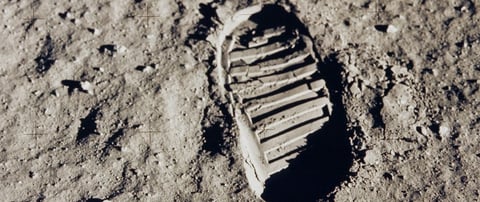In space
'The Anthropocene in the solar system' by Alice Gorman (2014)
This paper is really important for showing how the material residues and stratigraphic traces of human activities extend beyond the Earth system into orbital space, and onto surfaces of other bodies in the solar system. "The boundaries of Spaceship Earth have already been breached by human activities", as the author puts it. Incipient archaeosphere deposits with human artefact inclusions have formed on the moon, and rocks from the moon have been transported back to Earth. There has been an exchange of geological material. On the basis of such evidence, Gorman frames the Anthropocene and its material record (the archaeosphere) as more than merely global in extent. It is spreading out into the wider solar system.
Gorman, A. C. 2014. The Anthropocene in the Solar System. Journal of Contemporary Archaeology, 1 (1), 87-91. Doi: 10.1558/jca.v1i1.87 Available on ResearchGate


Human footprint on the surface of the moon. Image courtesy of NASA
'Surveying Fermi's Paradox, Mapping Dyson's Sphere: approaches to archaeological fieldwork in space'. Chapter by P.J. Capelotti (2009)
The paper is significant because it contains (as far as I can tell) the first use of the term ' archaeosphere'. The term refers to the mapping of traces of human remote-controlled activities on the surface of Mars. In the following year (2010), Capelotti uses the same term to describe traces of human activities on Earth, as detected by satellite images and remote sensing, though he never really defines the term or develops the idea further. Nevertheless, the origin of the archaeosphere term in space archaeology is important to note. The archaeosphere as a global scale entity is so massive we never really grasp it in anything like its totality from our very situated perspective on the Earth's surface. It only begins to emerge into our consciousness through looking back at the Earth from space.
Capelotti P.J. (2009). Surveying Fermi’s Paradox, Mapping Dyson’s Sphere: Approaches to Archaeological Field Research in Space. In A.G. Darrin and B.L. O'Leary (eds) Handbook of Space Engineering, Archaeology, and Heritage. Boca Raton, CRC Press. Available on ResearchGate